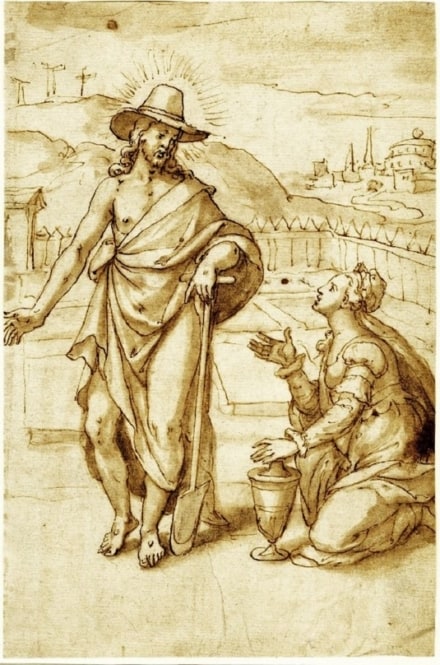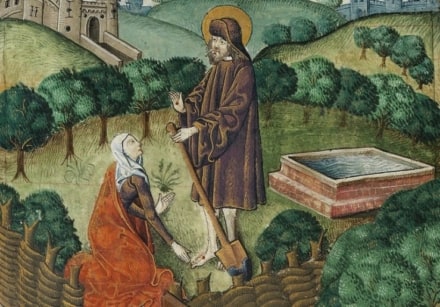
Sermons
The Garden of New Beginnings
April 17, 2022
Resurrection of the Lord/ 17th April 2022
Only John tells us that the tomb was in a garden. Not Matthew. Not Mark. Not Luke. Only John. Matthew, Mark, and Luke, the so-called synoptic Gospels, are closely related and present, for the most part, one view of Jesus. John is a horse of a different color; he’s doing his own thing. And, so, is John a reliable witness? In our cynical age, wary of fake news and those that play with the facts, it’s easy to doubt its historical veracity. Did John get his facts wrong? Can he be trusted? Legitimate questions, although they probably say more about us than the truth of John’s Gospel. The Gospel writers were not trying to be historians, and while they bear witness to something that occurred in history, the Gospels are not histories. Instead, the Gospels are Gospels, theological narratives making theological claims. And the theological claim that John is making is rooted in what’s going on in his garden, in what’s coming to life there.
John—and only John—tells us, “Now there was a garden in the place where [Jesus] was crucified, and in the garden there was a new tomb in which no one had ever been laid” (Jn. 19:41). Now, this is a very odd verse. John agrees with the other Gospels that Jesus was crucified at The Place of the Skull (Jn. 19:17), which was outside the city walls—a ghastly place. But John tells us that there was also a garden there. This doesn’t make any sense. There’s something not quite right about this. It’s a curious detail. It’s important to remember that nothing in his Gospel is there by mistake. Every detail has meaning—which actually makes John fun to read as we try to figure out what’s going on. And so if we sit with this detail, slowly it begins to dawn on us that maybe something else is going on. Soon we make the shift, we move from the literal and cross the threshold into the world of the symbolic—and there we begin to see that John is telling us something other than history, that he’s unveiling a deeper truth about the meaning of Jesus and what his life means for us and the world. Yes, John places both the death and the resurrection in a garden—this is no mistake.
For John and his community, the word “garden”—kepos in Greek—would have generated thoughts of another garden, the garden of Eden. In fact, it wouldn’t have been a massive leap for them, the first readers and hearers of John, to make this connection because the entire Gospel is intentionally designed as a response to the book of Genesis. The opening words of John’s Gospel, which we often hear at Christmas, “In the beginning was the word, and the Word was with God, and the Word was God” (Jn. 1:1), point back to the original, “In the beginning when God created the heavens and the earth” of Genesis 1:1. From the start, we have the first clue that John is up to something. He has an agenda. The God who created the heavens and the earth and swept over the formless void and deep darkness of the waters, who created light, and filled the earth with everything good, who breathed life into dust, into soil to create human beings in the divine image, gave them a garden to till and to keep. The garden contained many trees, including one, the “tree of the knowledge of good and evil,” from which they should not eat (Gen. 3:3). Well…we all know the rest of the story, we know what happened next. The sorry trail of human tears and suffering, the story of our alienation and separation from God, from neighbor, from self, from the soil, and all created things.
John and his community believed, however, that the birth, life, death, and resurrection of Jesus signaled God’s determination to recreate, restore, and renew the garden. Genesis depicts God as the first gardener, and “they heard the sound of the LORD God walking in the garden at the time of the evening breeze” (Gen. 3:8). The prophet Isaiah wrote, “For as the earth brings forth its sprouts, and as a garden causes what is sown in it to sprout up, so the Lord God will cause righteousness and praise to sprout up before all the nations” (Is. 61:11). Later, think of Jesus’ description of God as a vinedresser, who cared for a vineyard, which is only in John’s Gospel (Jn. 15:1-11). For John’s community, whatever happened on the cross—and who can fully fathom it?—at a minimum, it is clear that the place of the skull is also a garden—a garden with a new tomb, which is the place of both death and resurrection.
It is no mistake, then, that John—and only John—tells us that Mary Magdalene at the tomb first thought that she was talking to the gardener—driving the point home. Jesus is the gardener of God’s new creation, a new Eden. The connection with Genesis is all over John’s telling of that first Easter morning. For example, in Genesis 3:3, Eve said to the serpent that they were not to touch the tree in the middle of the garden. The same Greek verb used in the Greek Hebrew Bible (the Septuagint) is used when Jesus tells Mary not to touch or hold onto him (Jn. 20:17). That’s intentional. The original mistake in Eden will be undone. And not only is Jesus the gardener, but he’s also now the tree of new life whose fruit we’re allowed to eat, a tree whose leaves are for the healing of the nations (Rev. 22:12).
And twice John tells us that Jesus rose on “the first day” of the week as if this were the first day of a new creation. In Genesis, God completed God’s work on the sixth day and rested on the seventh, the Sabbath, making the eighth day the first day of a new week. Jesus finished his “work” on the cross on Friday, the sixth day, rested in the tomb on the Sabbath, the seventh day, and rose on the eighth day, making the “first day” of the week the first day of the new creation. In Jewish numerology, the eighth day is the first day, the day of new beginnings. There’s a beautiful verse in the Epistle of Barnabas, which was almost included in the New Testament, written between 70 and 132 CE, that reads, “After I have set everything at rest, I will create the beginning of an eighth day, which is the beginning of another world.” I love this.
John’s view of Jesus also resonates with how the apostle Paul spoke of Jesus as the Second Adam in Romans 5 and 1 Corinthians 15. In their own way, John and Paul point to Jesus as gardener of the new Eden, doing what Adam could not do. “Jesus’s resurrection broke new ground, marking the beginning of a massive restoration,” or, perhaps, better—a re-creation project.[1]
This motif of Jesus breaking new ground can be found in the resurrection art in Renaissance and Baroque Europe. Jesus is often depicted toting a shovel (or hoe). Sometimes is slung over his shoulder; sometimes, he’s leaning on it.
The image of Jesus as gardener of the soul was common from the fourteenth century through the eighteenth century. “As gardener, he’s the caretaker of humanity, bending down to bring us up, to make us whole and healthy and beautiful.”[2] There are wonderful paintings with Jesus wearing the clothes of a field worker and sporting a floppy gardener’s hat. The image lost its power when we left the fields and moved into cities where our lives were ruled by technology, nature was viewed as something to be subdued, conquered, and used for our selfish pleasures.
Jesus-as-Gardener is not a familiar image for us—but maybe it should be. I have come across the work of several contemporary artists, not many, depicting Jesus wearing overalls, sporting a straw hat, and carrying a shovel.[3] I find this a compelling image, not because I have a green thumb—I don’t—but because we need this image.
The early church, particularly John’s community, saw the resurrection as the extension of God’s work as creator and gardener. Jesus is the gardener of our lives, planting, tending, sometimes pruning, nurturing, and growing something new and beautiful in us. Imagine if we lived into this image and people viewed the church as a garden—all of us together as God’s garden, with shovels in hand, called to break to new ground, where we tend and care for and nurture the seeds of new life God is planting in us, cultivating all that God is growing through us, grafting us into the vine, the tree, whose leaves are for the healing of the nations—which takes on new meaning for us in a world where nations are at war with nations and lives are being torn apart. There’s a garden that needs tending.
And here is the good news: We are children of the eighth day. We are children of new beginnings. Children of the new creation. Children of resurrection. So grab your shovels. For Christ is risen! He is risen indeed!



“Christ Appears to Mary Magdalene as a Gardener” (detail),
ca. 1503–1504, England. Fol. 134v,
Vaux Passional (Peniarth 482D), National Library of Wales.
——————————————————
[1] [1] See Victoria Emily Jones’s marvelous essay “She mistook him for the gardener” at ArtandTheology.org, https://artandtheology.org/2016/04/05/she-mistook-him-for-the-gardener/.
[2] See https://artandtheology.org/2016/04/05/she-mistook-him-for-the-gardener/.
[3] See https://artandtheology.org/2016/04/05/she-mistook-him-for-the-gardener/.